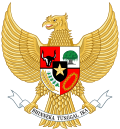Second Ali Sastroamidjojo Cabinet Kabinet Ali Sastroamidjojo II | |
|---|---|
| 17th Cabinet of Indonesia | |
| 1956–1957 | |
 | |
| Date formed | 24 March 1956 |
| Date dissolved | 9 April 1957 |
| People and organisations | |
| Head of state | Sukarno |
| Head of government | Ali Sastroamidjojo |
| No. of ministers | 27 ministers |
| Member party | PNI Masyumi ContentsIndependent |
| Opposition party | PKI PSI |
| History | |
| Predecessor | Burhanuddin Harahap Cabinet |
| Successor | Djuanda Cabinet |
| ||
|---|---|---|
Pre-independence Domestic policy Foreign policy Family Media and legacy | ||
The Second Ali Sastroamidjojo Cabinet [1] (Indonesian : Kabinet Ali Sastroamidjojo II), also known as the Ali-Roem-Idham Cabinet (Indonesian : Kabinet Ali-Roem-Idham) was an Indonesian cabinet that served from 24 March 1956 until 9 April 1957.

